
Modernizing aging buildings, increasing affordable senior housing stock, investing in workforce recruitment and retention, and financing are key factors in a blueprint for building the national aging infrastructure unveiled Thursday by LeadingAge.
The organization’s Blueprint for a Better Aging Infrastructure plan, which spans the long-term care continuum from affordable housing to home- and community-based services to skilled nursing, comes on the heels of President Biden’s $2 trillion infrastructure plan released Wednesday, which elevates health and senior care to “infrastructure” status.
“This is the most important moment in a generation for aging services,” LeadingAge President and CEO Katie Smith Sloan said. “Our country doesn’t have the infrastructure for aging services that we need to care for our rapidly aging population, and the systems we do have are crumbling. It is no longer acceptable that our system largely ignores a set of services half of Americans will need at some point in our lives.”
A strong aging services infrastructure, Sloan said, will offer economic benefits beyond the sector, including healthcare cost savings, job retention and economic development.
Affordable senior housing
The plan calls for increasing the stock of affordable senior housing, along with age-friendly retrofits to existing housing, as well as expanding the number of service coordinators in such communities.
Specifically, the plan asks for a $2.5 million investment in the Department of Housing and Urban Development Section 202 Supportive Housing for the Elderly Program to build approximately 54,000 homes, and $1 billion in an Age Friendly Retrofit program for HUD-assisted senior housing, to improve physical structures to include health and wellness activities and to improve air ventilation systems.
Redefining broadband as a subsidized utility through a $5 billion investment also would enable equal access to the telehealth, economic and social connectedness benefits of the internet, according to LeadingAge.
Workforce
The plan also addresses aging services workforce shortages, which were exacerbated by the pandemic. Specifically, LeadingAge calls for permanently increasing the Medicaid federal medical assistance percentage match by 10% for both HCBS and nursing home services; investing in competency-based training programs; enhancing career pathways; adding funding and programming to train geriatric nurses and physicians; and supporting immigration policies that benefit aging services and provide a path to citizenship for workers.
The LeadingAge plan also supports a living wage, determined locally, for all aging services workers across the continuum of care. LeadingAge also is asking that providers be fully reimbursed to cover wages and benefits.
Dorothy Davis, president and CEO of Atlanta-based Visiting Nurse Health System, said that workforce shortages and gaps are consistent across service lines, including in its Medicaid waiver long-term supportive service division. Biden’s infrastructure plan, she said, gives her a “sense of hope” that there is a plan to address workforce gaps that will grow along with the aging population.
HCBS
Expanded funding and program support for Medicaid HCBS is necessary, according to LeadingAge, to allow more older adults to access necessary services “wherever they call home.”
This means reclassifying these benefits as “mandatory” in a geographically equitable way; helping states develop and improve HCBS capacity; modifying home health benefits to include more personal care, technology and other services; and providing access to technological infrastructure investments to HCBS providers.
Some assisted living operators provide HCBS through Medicaid waivers.
COVID comeback
In an effort to help providers rebound from the financial costs of the pandemic, the association’s blueprint calls for a $6 billion “Hardest Hit” Provider Relief Fund for aging services and long-term care providers. The plan also seeks coverage of ongoing COVID-19-testing and personal protective equipment costs.
“COVID relief is not the main point as we look to prepare for the future, but it is critical that we support the good parts of today’s aging infrastructure,” said Ruth Katz, LeadingAge senior vice president of public policy and advocacy. “As Congress moves on with infrastructure, we urge that they not lose sight of where aging providers are to start.”




